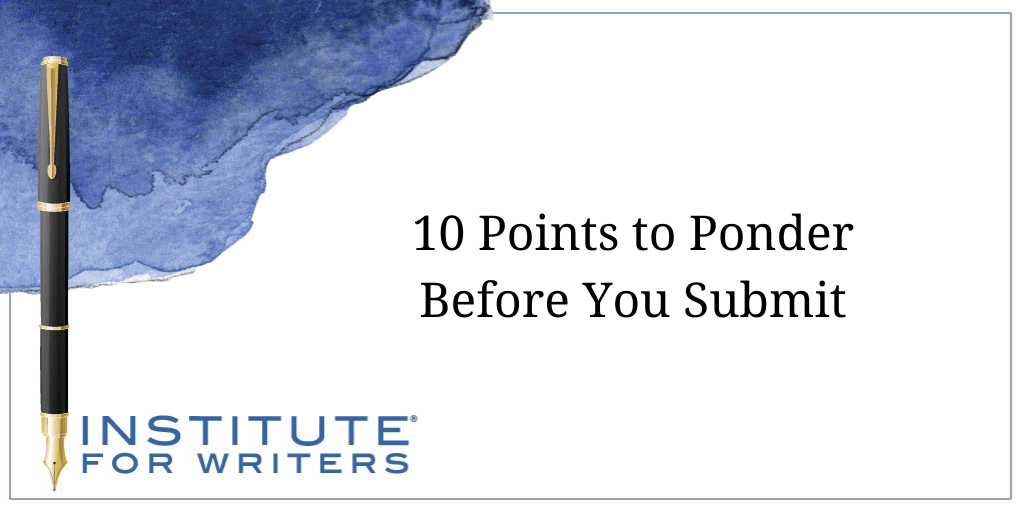
10 Plot Pitfalls to Think About
Plot can be tricky, and, as a writer, you need to be aware of what makes or breaks plot. Take a look at 10 different things to avoid in your own writing.

This blog post was somewhat drafted a couple weeks prior to me judging a contest at the Institute. I judged a writing contest a few years ago for the Institute and welcomed the opportunity to jump in again, so I laid the partially completed draft aside to read and assess the submitted contest entries.

I finished my first reading of each entry and thought about their strengths and weaknesses—and compared what I read with the traits on the scoring rubric I was using. I eliminated some entries after that first reading and then let the manuscripts rest for a few days. I returned to my drafted blog post and revised it based on my contest notes. Sure, these ideas have been mentioned before, but even terrific writers may not realize their importance.
Since we are all striving for publishing success, let’s take a fresh look. Here are 10 points to ponder before you submit your writing:
Those reading most contest entries (and submissions) expect a name and heading on top of the first page. The page 1 heading is similar to the one the Institute requires at the top of course assignments: Name, Date, Word Count, and your email address. Then space about halfway down the first page and write the title.
The title is important and not naming your story or article is similar to not naming a pet or a person—how will you refer to that entity you have created? How will an editor talk about it? Remember that a title doesn’t have to be permanent and sometimes an editor will suggest a revision to your original title.
In most cases, the guideline’s stated word count is not negotiable. Some writing articles suggest that going 10 percent over a word count is not a big deal, and that may be true for some markets and some editors, but it is best not to take a chance. At writers’ conferences I have attended, editors often say that a too-high word count is one way to eliminate a manuscript from their sky-high submissions pile. It is not difficult to abide by a market’s stated word count, and it is crucial when there are so many writers submitting their work.
Almost all manuscripts are expected to be submitted double-spaced. Single- and triple-spacing are not considered the industry standard. Set your Word (or other) spacing option to 2.0 if your template does not default to that spacing.
Some students I work with are unsure of how to set double-spacing on their documents, and I always suggest they do an online search of “Double-spacing in Word” (or whatever your program may be). This will bring up basic articles and helpful videos that walk writers through this essential formatting style.
Most editors expect to see manuscripts written in Arial, Times New Roman, or Courier New. If an editor prefers a different font type, they will state that in their guidelines.
Font size is important too. Some new pages default to 11-point Calibri font, but all text should be presented in 12-point size.
Some writers insert exclamation marks as standard end-of-sentence punctuation throughout their manuscript, forcing the reader to Be Amazed! again and again at the sentences they have just read. As we know, good writing shows readers what is happening rather than telling them how to feel. Remove this punctuation mark from your text and use good word choice to show readers what they need to know.
The Word program has some helpful features to assist in proofreading and ones that should not be ignored are the colored lines the program draws under words that are misspelled, not grammatically correct, or areas that are not punctuated correctly. Scroll through your manuscript and if you see a line under any words or phrases, figure out what is wrong by clicking on it.
Those six potential trouble spots are the easiest to remedy. Here are some content issues that are worth mentioning and perhaps a bit trickier:
Most writers present their stories and articles in past tense, but those written in present and future tense work well too. One task as a writer is to ensure that your verb tense stays the same throughout your manuscript. It is easy to inadvertently insert an opposing tense and not notice it until you deliberately look:
Nico walked into the house. He puts on his glasses to see better and turns on the kitchen light. It was still hard to figure out where the noise is coming from.
Ensure that your verb tenses are aligned by doing one complete proofread to only look for that.
It is impossible to get to know, care about, or connect with more than a few characters (ideally: two) in a short story or essay. Using the introductory paragraph to name as many family members as were sitting at the dinner table is only going to confuse your readers. Concentrate on the people who are directly involved with the story – who have a task. If you can meld two characters into one, do it. Asking your readers to keep a half dozen characters straight could cause them to abandon the manuscript.
Most fiction is read for pleasure, so don’t make it unnecessarily complicated. Ideally, your audience should breeze through the story or essay and not have to reread any of it.
Have someone else read it before you submit your writing—sometimes we writers are too close to the story and don’t realize we are not explaining as well as we mean to.
Some writers use the last paragraph of their story, article, or essay to tell their readers what the manuscript was about. They let the readers know what a character learned from the experience or a lesson readers should take from reading. This causes readers to wonder why they read the manuscript in the first place—they could have just read the ending.
Trust that your manuscript shows the readers what you want them to know and resist the urge to help them see the lesson you hope they take from the story.
Create a checklist of each of these ten components and review it before you submit your writing. It is a sure thing your submission will be stronger as a result.
Susan Ludwig, MA has been an instructor with the Institute of Children’s Literature for over 17 years. Susan’s writing credits include teacher resource guides, English language learner books, and classroom curriculum for elementary through high school students. A former magazine editor, she assesses students’ written essays as a scoring director for the SAT exam. When she is not writing or working, she is usually found playing with her grandsons or curled up with a good book.

Plot can be tricky, and, as a writer, you need to be aware of what makes or breaks plot. Take a look at 10 different things to avoid in your own writing.

Plot is more than just the chain of events within a story. There are so many elements to plot to consider when writing. Let’s dive into those elements.

Visiting new places is key to exploring new ideas and finding inspiration. Let’s see the places you can go this summer to spark your next story.
1000 N. West Street #1200, Wilmington, DE 19801
© 2024 Direct Learning Systems, Inc. All rights reserved.
1000 N. West Street #1200, Wilmington, DE 19801
© 2025 Direct Learning Systems, Inc. All rights reserved.
1000 N. West Street #1200, Wilmington, DE 19801
©2025 Direct Learning Systems, Inc. All rights reserved. Privacy Policy.
4 Comments